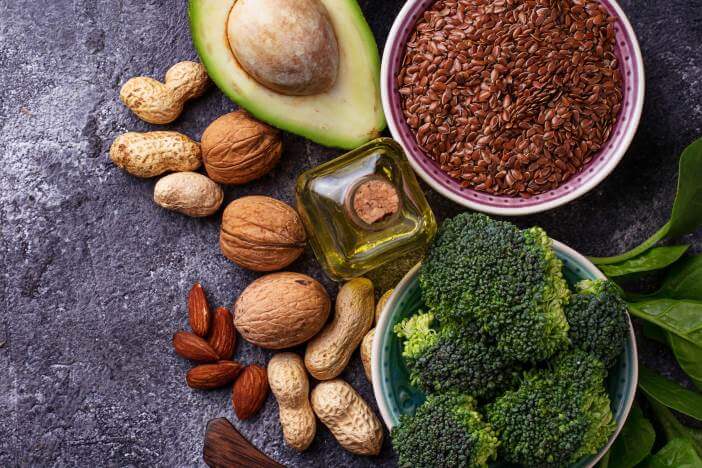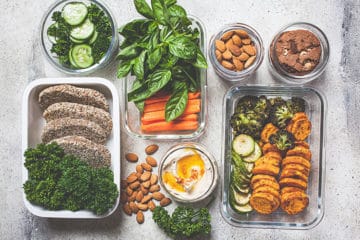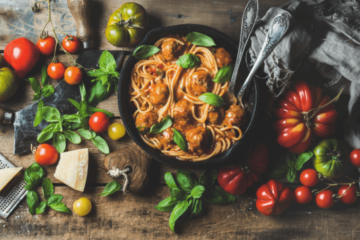Intolerances, intolerances and allergies – things to pay attention to

What is a food intolerance?
The term intolerance describes the condition that occurs when your body can not properly process certain substances when they are ingested. Unlike an allergy, the immune system in not responsible for the symptoms of a food intolerance, but rather the lack of individual enzymes or transporters responsible for the breakdown and digestion or transport of certain food constituents between the digestive organs is responsible. A lack of enzymes or transporters in the digestive tract thus makes it impossible for some people to completely process and digest products that contain, for example, lactose, fructose, or gluten. Unpleasant reactions, such as cramping, nausea, diarrhea, or flatulence are the result of this deficiency.
Allergies have even more drastic consequences than food intolerances, which can be known to be life-threatening, but affect only about two to three percent of the population and are often limited to individual foods. A food intolerance is much more common: it’s estimated that nearly 20% of the world’s population has a food intolerance. The most common form of intolerance is a fructose intolerance. Lactose intolerance affects about fifteen percent of the population, with symptoms that are often quite noticeable. Almost one in ten reacts badly to gluten and about one in every one hundred people is allergic to histamine. Regular ingestion of these foods has not only bad effects on the quality of life, but also on health – especially our intestines suffer in the case of intolerance. Nevertheless, many sufferers find it difficult to choose the right foods and to find their way around the supermarket.
Upfit makes it possible to provide you with a balanced, delicious, and healthy nutritional Plan despite your intolerance. Give us information that goes beyond intolerance and we’ll translate that into your nutritional Plan for your goals. Whether you want to lose weight, eat a healthy and balanced diet, or take the first steps toward a a nutritious diet full of variety despite intolerance, the Upfit experts are here to help you.
You would like to test out the Plans now? Then just download one of our free nutrition plans – adapted to your intolerance and goal – and see for yourself!
Intolerances are not the same allergies
The most important differences between intolerances and allergies are the reactions. Some intolerances are so strong that they lead to so-called “pseudoallergic reactions”. These reactions, such as swelling, respiratory problems or skin rashes, are triggered by the same cells that are responsible for allergies. The symptoms of most intolerances, however, are limited to the deficiency of enzymes in the stomach. The typical reactions are nausea, cramping, and digestive problems, and although not life-threatening, are still profoundly unpleasant. Thus, one can say that usually a person with allergies must be much more meticulous with Nutrition Planning, than a person with intolerance, as the threat of life is much higher in allergies. Nevertheless, one should not take an intolerance lightly.
Symptoms of a food intolerance
Many people are not aware of their food intolerance, as symptoms appear chronicle and are considered to be commonplace or normal. If you experience the following symptoms, intolerance is not unlikely:
- Bloating / flatulence
- Digestive problems
- (Cramping) abdominal pain
- Food cravings
- Burning on the tongue
- Racing heart
- Headache
- Fatigue / insomnia
Do not take these symptoms as “normal” because they are not and most of the time there is a way to get them under control. By phasing out food groups that contain either fructose, lactose, gluten, or histamine, you can figure out what’s good for you in a reasonable amount, and what you should avoid. Upfit will help you in the process of finding a healthy and tasty diet with a nutritional plan adapted to your intolerance and achieving your goal weight. (Tip: determine your optimal body weight easily with our BMI calculator.)
Food intolerances in detail
Histamine intolerance
Histamine intolerance is a congenital or acquired metabolic disorder that is influenced by environmental factors and bodily components but does not affect the immune system. The affected person is no longer able to maintain the level of histamine at a set point when released in bulk from the body’s own storage cells, or when dietary foods containing histamine, such as sausage, cheese, or red wine, enter the digestive tract. The reason is that the body of a person with histamine intolerance has problems to break down the body’s enzyme histamine. The fact that the enzyme degradation is disturbed in the intestinal flora leads to allergy-like, poisoning, or flu-like reactions. From migraine, to respiratory ailments and cardiac arrhythmias, to itching and gastrointestinal discomfort, a broad range of symptoms is possible with histamine intolerance. People who suffer from histamine intolerance often do not know about it and live with the intolerance for a very long time without changing their diet and thus improving their quality of life. If you are unsure if Upfit fits your intolerance, check out our selection of free Nutrition Plans for histamine intolerance now and see for yourself.
| AFFECTED FOOD | DIGESTIBILITY* |
|---|---|
| Fish smoked | Red |
| Fish (Preserve) | Red |
| Avocado | Red |
| Sauerkraut | Red |
| Hard cheese (mountain cheese, Parmesan) | Red |
| Soft cheese (Brie, Camembert) | Red |
| Sliced cheese (Edamer, Gouda) | Red |
| Spinach | Red |
| Beef | Red |
| Vinegar | Red |
| Wines and sparkling | Red |
| Wheat beer | Red |
| Tomato | Red |
| Citrus fruits | Orange |
| Fruits (strawberries, pineapple, kiwi, orange, Pear, banana, raspberries) | Orange |
| Chocolate | Orange |
| Wheat germ | Orange |
| Seafood | Orange |
| Mushrooms | Orange |
| Nuts | Orange |
| Legumes | Orange |
Lactose intolerance
As the name already describes, people affected by a lactose intolerance can not break down lactose, and therefore can not digest it. Lactose is composed of glucose (so-called grape sugar) and galactose and thus forms a double sugar. For the breakdown of lactose into its two components, the body needs lactase in the small intestine. The intestinal mucosa can not absorb lactose, but glucose and galactose, and thus lactase deficiency in the small intestine forms the problem of intolerance. The body is also able, with the help of intestinal bacteria, to decompose the milk sugar without lactase (or with very little lactase) by fermenting it. The gases produced during fermentation, hydrogen and methane, are responsible for the typical symptoms, such as bloating, flatulence, and cramping stomach aches. Lactose is found in milk and milk products such as yoghurt, cottage cheese, and soft cheese, but is often also used as a moderate sweetener in finished products such as skimmed milk powder, buttermilk powder, E966 (lactitol), whey powder and many other products.
If you are unsure if Upfit fits your intolerance, you can look at the free lactose intolerance diet Plans and convince yourself of the choices.
| Affected Food | Lactose in g / 100g | Digestibility* |
|---|---|---|
| Buttermilk | 3,5-4,0 | Red |
| Kefir | 3,5-6,0 | Red |
| Cream/Whipped Cream | 2,8-3,6 | Red |
| Creme Fraiche | 2,0-3,6 | Red |
| Butter | 0,6-0,7 | Orange |
| Whey | 2,0-5,2 | Red |
| Quark | 2,0-3,8 | Red |
| Processed cheese | 2,8-6,3 | Red |
| Ready made desserts (eg pudding) | 3,3-6,3 | Red |
| Milk Ice cream | 5,1-6,9 | Red |
| Cream cheese | 2,0-3,8 | Red |
| Cottage cheese | 2,6 | Red |
| Yoghurt | 3,5-6,0 | Red |
| Coffee creamer | 3,8-4,0 | Red |
| Condensed milk | 9,3-12,5 | Red |
| Lean quark | 4,1 | Red |
| Goat’s milk | 4,0-4,2 | Red |
| Sheep’s milk | 4,4-4,7 | Red |
| Cow’s milk | 4,7 | Red |
| Milk powder | 38,0-51,5 | Red |
Fructose intolerance
Similar to lactose, people with fructose intolerance have problems digesting fructose. Fructose is present in many fruits, but also in half of normal table sugar and the main constituent of many syrup or thick juice products. The body must first convert the ingested fructose in the liver to its close relative glucose in order to use it. In case of intolerance, either the remodeling itself may be disturbed or the transport of fructose from the intestine to the liver. Overall, a distinction is made between three different intolerances. Fructosemia or fructosuria constitute an intolerance that is not in need of treatment and is usually only diagnosed at random. The breakdown of fructokinase, a liver enzyme, can cause an accumulation of food fructose in the blood (fructosemia) and urine (fructosuria). When colloquially fructose intolerance is used, this usually refers to fructose malabsorption. This is a disorder in the transport system of the intestine. A dysfunction of the transport proteins has the consequence that the fructose is not completely fed to the metabolism, but migrates further into the large intestine where it is decomposed with the help of bacteria and transported away. As in the case of the fermentation of lactose, the gases hydrogen and methane, which cause the familiar symptoms such as an abdominal distension, bloating and cramping stomach pains, are also produced here. The third form of fructose intolerance is hereditary fructose intolerance. This is a hereditary metabolic disease and is the most dangerous (fructose) intolerance. At an estimated frequency of 1: 20,000, it represents the very rare form, which should be taken care of medically, as it can lead to life-threatening poisoning.
If you are unsure about whether Upfit fits your intolerance, you can look at the free fructose intolerance plans and convince yourself of the choices.
| Affected Food | Fructose in g / 100g | Digestiability * |
|---|---|---|
| Apple | 5,7 | Red |
| Pineapple | 2,6 | Orange |
| Watermelon | 3,9 | Red |
| Banana | 3,6 | Red |
| Pear | 6,7 | Red |
| Beans | 2,2 | Orange |
| Berries | 1,3-4,1 | Orange-Red |
| Dates / Raisins | 31,3 | Red |
| Grapes | 7,6 | Red |
| Red Pepper | 3,7 | Red |
| Grapefruit | 2,5 | Orange |
| Onions | 1,1 | Orange-Red |
| Cabbage | 1,9 | Orange |
| Honey | 37,5 | Red |
| Cherries | 6,2 | Red |
| Kiwi | 4,4 | Red |
| Kohlrabi | 1,1 | Orange |
| Pumpkin | 1,6 | Orange |
| Mandarin | 1,3 | Orange |
| Orange | 2,9 | Orange |
| Plum | 2 | Orange |
Gluten intolerance (celiac disease or gluten sensitivity)
Also in the case of gluten, a distinction must be made between two forms of intolerance. Celiac disease is a gluten intolerance that has features of allergy as well as an autoimmune disease. Among other things, it leads to a chronic inflammation of the intestinal mucous membrane, if the incompatible gluten gliadin or Gliadin is ingested. Gluten and gliadin are found mainly in grains such as spelt, barley, oats, greens and wheat. Those affected are usually required to completely abstain from gluten and to adjust their diet accordingly. The consequences of a chronically inflamed intestinal mucosa are far-reaching. Acute symptoms, such as digestive problems, bloating, as well as flatulences are just the beginning. If there is a steady inflammation of the intestinal mucosa, there may be problems in nutrient intake, as the intestine plays a fundamental role in the processing of nutrients. People who suffer from such intolerance should act quickly and change their diet before long-term damage occurs.
Gluten sensitivity is more common than celiac disease. While celiac disease can be properly diagnosed by examining the intestinal mucosa, many suffer from intolerance symptoms without the intestinal mucosa having inflammation. In this case, it is more difficult to find the trigger, a simple solution consists in the phasing-out of certain foods. Apart from abstaining from fructose or dairy products, the omission of gluten-containing products most often leads to a lasting improvement of the symptoms, and in this way a gluten sensitivity can be detected.
If you are unsure if Upfit fits your intolerance, you can look at the free gluten intolerance Nutrition Plans and convince yourself of the choices.
| Affected Foods | Disgestiability * |
|---|---|
| Spelt | Red |
| Wheat | Red |
| Beer | Red |
| Barley | Red |
| Rye | Red |
| Oat | Red |
| Semolina | Red |
| Couscous | Red |
| Bulgur | Red |
| Bread / Rolls | Red |
| “Normal” Noodles | Red |
| Sauces (thickened with flour) | Red |
| Pizza Dough | Red |
| Cake | Red |
| Biscuits | Red |
| Crackers | Red |
| Malt | Red |
| Barley | Red |
| Durum Wheat | Red |
| Pastry (waffles, pretzels) | Red |
| Cornmeal | Red |
* Orange = if necessary, digestible in small quantities; Red = not digestible, it should be completely omitted
Intolerance and Upfit: Configure a nutritional Plan that takes into account your intolerance or allergy now
Don’t you Are you not sure know exactly in which foods contain fructose, gluten, or lactose? Do you think losing weight with your intolerance is impossible and would only work with starvation and exercise to the point of exhaustion? We have developed an alternative for you.
With Upfit you can create your own individual Nutrition plan within minutes, tailored to your intolerance. We determine for you which foods you should eat and which you should avoid – often here the devil in details and there are substances added to your favorite foods that you would not expect. In addition, you tell us which ingredients you would like us to exclude, because, for example, they just don’t taste good to you, so you can enjoy your new Meal to the fullest! In addition to the nutritional Plan, our experts are always available to help you with questions related to your intolerance. Your life has changed unintentionally since the emergence of intolerance and you are increasingly experiencing sacrifice and disappointment with food?
Start an Upfit Nutrition Plan today and start a tasty and healthy new lifestyle despite your allergy or intolerance !



